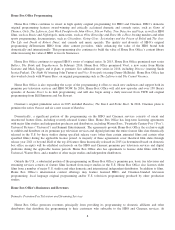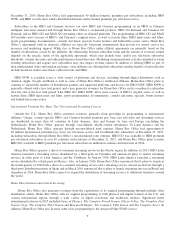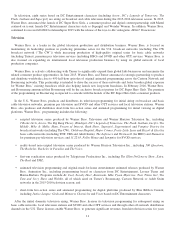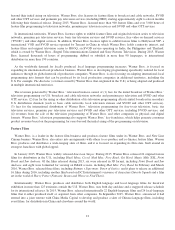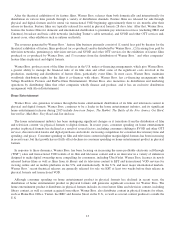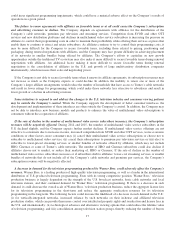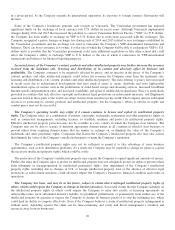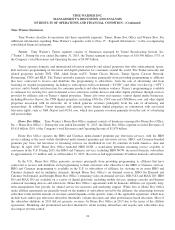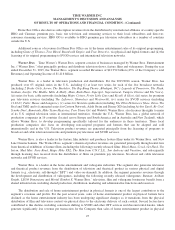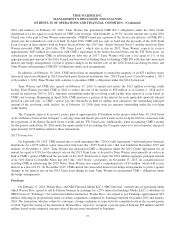Time Magazine 2015 Annual Report Download - page 32
Download and view the complete annual report
Please find page 32 of the 2015 Time Magazine annual report below. You can navigate through the pages in the report by either clicking on the pages listed below, or by using the keyword search tool below to find specific information within the annual report.for Warner Bros.’ programming. In international territories, the increasing popularity of locally produced television content
could result in decreased demand and lower license fees for the Company’s U.S.-produced television programming.
An increase in the costs incurred by Turner and Home Box Office to acquire or produce popular programming could
adversely affect the Company’s operating results. Competition to acquire popular programming is intense both in the U.S.
and internationally among networks and SVOD services. As more networks and SVOD services seek to offer distinctive
programming, including sports programming, and are willing to invest more to do so, Turner and Home Box Office may
have to increase the prices they are willing to pay for sports, original and acquired programming, including the renewal of
programming they currently license. Cable networks, premium pay television services and SVOD services are increasing
their investments in original programming, which could drive up talent and production costs. If increases in Turner’s and
Home Box Office’s costs to produce or acquire popular programming are not offset by increases in affiliates’ fees when
affiliate agreements are renewed and increases in advertising revenues for Turner’s cable networks, the Company’s results of
operations could be adversely affected.
The Company’s results of operations could be adversely affected if there is a decline in advertising spending, which
could be caused by a number of factors. A decline in the economic prospects of advertisers or the economy in general could
cause advertisers to spend less on advertising. In addition, television advertising expenditures could be negatively affected by
(i) further declines in multichannel video service subscribers; (ii) increasing audience fragmentation caused by increased
availability of alternative forms of leisure and entertainment activities; (iii) shifts in consumer viewing patterns, including the
increased use of digital video recorders to skip advertisements, increased numbers of consumers watching programming on
demand on a time-delayed basis, and consumers watching more non-traditional and shorter-form video online; (iv) a shift of
advertising to online and mobile offerings; (v) pressure from public interest groups to reduce or eliminate advertising of
certain products on television; (vi) new laws and regulations that prohibit or restrict certain types of advertisements; and
(vii) natural disasters, extreme weather, acts of terrorism, political uncertainty or hostilities, because there may be
uninterrupted news coverage of such events that disrupts regular television programming. In addition, advertisers’
willingness to purchase advertising time from the Company may be adversely affected by a decline in audience ratings for
the programming aired on Turner’s cable networks. If ratings decline significantly, Turner’s cable networks generally will be
required to provide additional advertising time to advertisers to reach agreed-on audience delivery thresholds. This may
result in Turner’s cable networks having less advertising time available to sell or use to promote their own programming. In
addition, if the television ratings system is not changed so that it captures the viewership of programming through digital
video recorders, VOD and digital platforms and devices, advertisers may not be willing to pay advertising rates based on the
increasing viewership that occurs after the initial airing of a program and on digital platforms and devices. Turner’s
advertising revenues may be adversely affected by plans Turner has announced to reduce the amount of advertising on select
programming on some of its cable networks to improve the viewing experience, if the actions do not result in improved
ratings and advertising rates for the programming with fewer advertisements. Finally, Turner’s advertising revenues from
online and mobile offerings could be adversely affected by technology that enables consumers to block advertisements.
The Company’s results of operations may be adversely affected if the Company’s efforts to increase digital sales of its
film and television content and make digital ownership of content more compelling to consumers are not successful.
Several factors have contributed to an industry-wide decline in sales of home entertainment products in physical formats in
recent years, including consumers shifting to SVOD and other OTT services and electronic purchases and rentals; consumers
electing to rent films using discount rental kiosks, which generate significantly less profit per transaction for the Company
than the sale of home entertainment products in physical formats; changing retailer strategies and initiatives (e.g., reduction
in floor space devoted to home entertainment products in physical formats); retail store closures; weak economic conditions;
increasing competition for consumer discretionary time and spending; and piracy. The Company’s efforts to offset the
decline in sales of home entertainment products in physical formats and to make digital ownership of content more attractive
to consumers may not be successful or may take several more years to become successful.
If the Company fails to compete successfully against alternative sources of entertainment and news, there may be an
adverse effect on the Company’s results of operations. The Company competes with all other sources of entertainment and
news, including television, premium pay television services, SVOD and other OTT services, feature films, the Internet, home
entertainment products, videogames, social networking, print media, pirated content, live sports and other events, for
consumers’ leisure and entertainment time and discretionary spending. The increased number of media and entertainment
18


